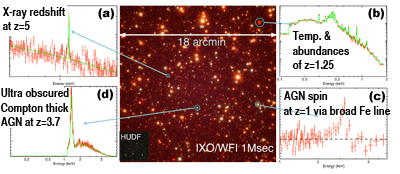 |
Goddard Space
Flight Center NASA > GSFC > Astrophysics Science Division > IXO |
|

High-energy phenomena in the X-ray band characterize the evolution of cosmic structures on both large and small scales.
On the smallest scales, X-rays provide the only electromagnetic spectral signatures from the regions of strong gravity near black holes through absorption and emission features, such as the Fe Kα emission line at 6.4 keV and its profile [Brenneman et al.], and can penetrate the surrounding gas and dust allowing us to uncover the earliest massive black holes and measure their distances [Nandra et al.]. In neutron stars, X-ray spectra and light curves carry the observable imprints of exotic processes occurring in these objects [Paerels et al.].

WFI Simulation of the Chandra Deep Field South with the Hubble Ultra Deep Field (HUDF) in inset. Simulated spectra of various sources are shown, illustrating IXO’s ability (clockwise from top left) to:
Click the image for a larger view.
On the largest scales, X-rays are essential for detecting the “missing” half of baryons in the local Universe, as a probe of both dark energy and dark matter [Bregman et al.] and to measure the energy deposited in the surrounding medium by AGN’s jets and winds [Miller et al; Fabian et al.].
Building on a rich technological heritage, IXO will have improved instrumental capabilities in X-ray imaging, timing, and spectroscopy far beyond the current generation of X-ray missions (e.g. Chandra, XMM, RXTE, and Suzaku). Moreover, IXO will carry an X-ray polarimeter, which will open a new window on the study of high-energy phenomena. See Science Performance Requirements. These will enable observations that will address the above science issues—among others—with unprecedented detail and precision.